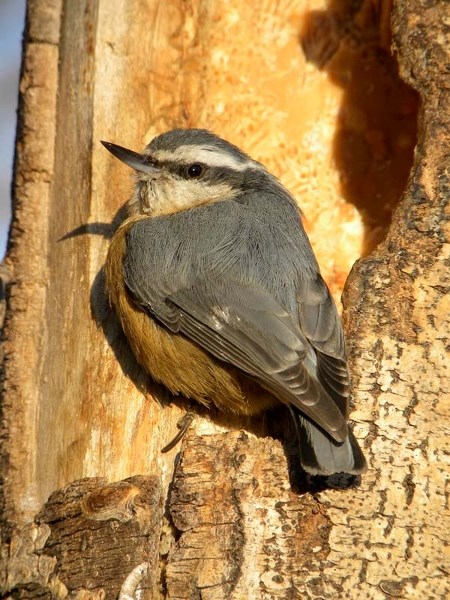My dad’s backyard has been a busy place as of late, home to robins, blue jays, a hyperactive squirrel and a rabbit that, despite the oncoming snow, is still a deep shade of brown.
But recently he told me that he’d seen a bunch of birds he couldn’t identify: small, blue and white, with a rusty breast.
“Did they go ‘nyerrp, nyerrp, nyerrp’?” I asked him.
“Yeah.”
“Red-breasted nuthatch.”
I was sure of it as soon as he mentioned the colouration, and the sound clinched it. There are only two birds in St. Albert that sound like a one-note tin horn, and just one of them has that colour of chest.
The red-breasted nuthatch is a chickadee-sized bird with short legs, a flat body, a big head and almost no neck. It has a black head with a white stripe that goes over its eyes, greyish-blue wings, and a rusty-red belly.
Closely related is the white-breasted nuthatch, which is about twice as big and has a white belly.
You’re most likely to hear these nuthatches before you see them: their trumpet-like calls are pretty loud, and a mob of them makes quite a racket.
You’ve got a red-breasted one if you hear a nasally “nyah nyah,” said local birder Ludo Bogaert, and a white-breasted if you hear a louder “yank yank.” If you hear either of them hissing at you, that means they see you as a threat.
Red-breasted nuthatches are best known for their complete ignorance of gravity when climbing trees. Unlike a woodpecker, which climbs from the bottom of a tree to the top, the nuthatch will go bobbing along head first – up, down, sideways and even upside down along a tree as it searches for bugs to eat, using its big hind toes to keep its grip. It’ll usually be tooting its own horn the whole time.
You’re most likely to find red-breasted nuthatches in coniferous forests, says local birder Alan Hingston, as they like to eat conifer seeds. White-breasted ones prefer poplars.
Although they do migrate, nuthatches often stay in St. Albert year-round, and are a frequent sight in the Christmas Bird Count.
Red-breasted nuthatch populations spiked during the 2001, 2003, 2007 and 2009 Christmas Bird Counts in St. Albert, Hingston notes, roughly doubling from the previous year each time. (They quadrupled in 2007 to an all-time high of 172.) Similar spikes were observed in Edmonton.
Hingston speculates that cone crops in coniferous forests were the drivers behind these spikes.
“If the cone crop isn’t very good in one place, they go somewhere else.”
He did not find similar spikes in white-breasted populations (which have slowly increased over the last 21 years).
Red-breasted nuthatches dig their own nest holes in trees, Bogaert said.
“They smear the outside of their nest hole with pitch,” he said – sometimes with the help of a stick as an applicator – presumably to fend off bugs and predators.
The nuthatch avoids the sticky pitch by diving straight into the hole, reports the Cornell Lab of Ornithology.
Wild red-breasted nuthatches prefer to eat conifer seeds, using their long, thin beaks to pry open the scales and get at the seeds within, reports Hinterland Who’s Who.
They also frequent bird feeders, said Jaynne Carre of Edmonton’s Wildbird General Store, where they prefer sunflower seeds, peanut butter, suet and nuts. Young nuthatches are particularly sociable, she noted, and will stand by and watch you fill a feeder even if you’re right next to them.
A nuthatch will typically fly to a feeder, grab one seed, and fly off to eat it, Bogaert said. Unlike the chickadee, which chips away at a seed held in its claws, the nuthatch will wedge its food in a convenient crack before hacking or “hatching” the shell off it – hence the name “nut hatch.”
While you’ll usually see nuthatches and chickadees flocking together, as they eat the same foods, you’ll sometimes see red-breasted ones bully other birds away from bird feeders.
“It fights above its weight,” Bogaert said.
Birdwatchers should set out heated water and a roost box if they want to help out the nuthatches in their yard, Carre says.
Next time I drop by my dad’s place, I plan to keep an ear out for these tiny trumpeters.
Red-breasted nuthatch
Name: <br />Sitta canadensis, a.k.a. upside-down bird, tomit, cardy bird, little quank.<br /><br />Appearance: <br />Chickadee-sized bird with blue-grey wings, rusty red breast, black head with white stripe through the eye.<br /><br />Commonly seen:<br />Climbing head first down a tree, going “nyah nyah nyah” at other birds and their concepts of up and down.<br /><br />Occasionally confused with: <br />The white-breasted nuthatch, which is twice as big and has a white breast.<br /><br />Fun fact: <br />Arborists can use them for pest control, as they feed on a pear-tree pest called the pear psylla.
Wild St. Albert
Like wildlife? So do we! Every second Wednesday the Gazette profiles a reasonably common wild creature in the St. Albert region. Birds, beasts, bugs, fish … so long as it's alive and kicking, we’ll feature it. <br /><br />Got a creature you’d like to see profiled? Send your suggestions to [email protected].




